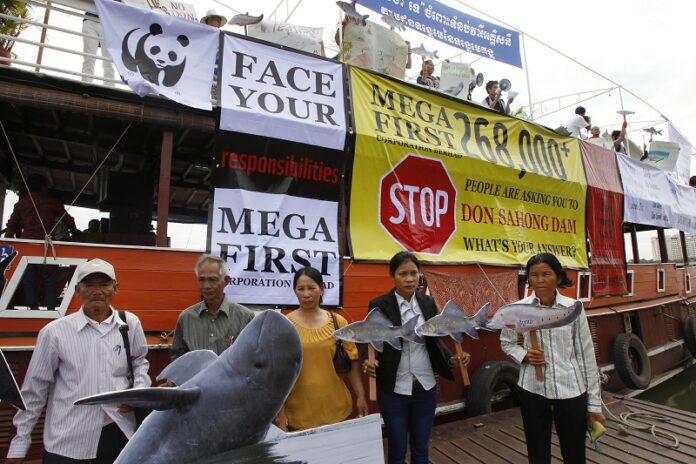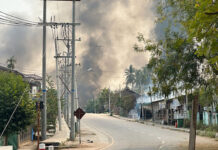
BANGKOK — When Western governments began pouring money into the Mekong River Commission, they hoped it would help four Southeast Asian countries cooperate in responsibly managing one of the world’s great rivers.
Two decades later, they have a surfeit of disregarded reports to show for the $320 million they spent, and a cascade of hydro power developments that benefit the narrow interests of dam builders but are ravaging the river basin, a crucial source of rice, fish and livelihoods for 60 million people.
Critics say the commission, formed when Laos, Cambodia, Vietnam and Thailand signed the Mekong River Agreement in 1995, has been sidelined by those governments. The four countries are more at odds than ever over use of the 4,800-kilometer-long (3,000-mile-long) river that begins in Tibet and snakes through their territories.
Consultations for the contentious Xayaburi and Don Sahong dams by Laos on the Mekong’s mainstream severely damaged the commission’s credibility. The other countries opposed the Lao plans, fearing damage to fisheries and the Mekong’s rice bowl delta, and the commission failed to broker an agreement.
On each occasion Laos was already working on the dams while it went through the motions of consultation. Before that, the commission’s reputation was already hanging by a thread; it paid several million dollars for a scientific study that recommended a 10-year moratorium on dam building but it was not adopted as an official document because of disagreement among the member countries.
Donor funding has shriveled and the commission’s staff has been slashed from about 160 to 66.
The largest donor, Denmark, provided $86 million of Danish taxpayer money to the commission since 1995 before ending its funding last year, said Kurt Morck Jensen, chief technical adviser to Denmark’s development agency during that period.
The funding slump coincides with cuts by Western governments of foreign aid programs they view as the least deserving. The commission needs $65 million for 2016-2020 and has secured $43 million so far. It received more than $100 million in the previous five-year period.
“There is a risk that a Mekong River Commission without donor support could further lose influence,” said Jensen. “On the other hand, donors cannot and should not be babysitting the MRC forever.”
Denmark used a critical review of the commission it conducted in 2013 to press for a faster withdrawal by foreign donors. Originally, the organization was supposed to be totally funded by its Southeast Asian member countries by 2030. Denmark recommended that be brought forward to 2020.
The Danish report:
— Criticized gaps in the commission’s knowledge that meant Vietnam and Thailand, which also fund the commission, had to conduct their own research to collect fundamental data about the river;
— Cast doubts the commission could accurately predict the effects of mainstream dams on fisheries and agriculture or know the threshold at which the river’s development would reach a damaging point of no return;
— Questioned whether it had sufficient knowhow to advise member states how to mitigate the impact of dams;
— Queried an “unusual” amount of time and money spent on travel, meetings and workshops.
Consultants hired by Denmark concluded “there is generally little evidence of value for money.” They found instances of drivers and secretaries being listed as professional participants in meetings to make up numbers, unjustified study tours of the Danube River in Europe and to the United States and Canada, and other wasteful spending.
The commission’s CEO from that time, Hans Guttman, did not respond to emailed questions.
Philip Hirsch, a professor of human geography at Sydney University and a Mekong expert, said donor money also paid for valuable scientific research. But the commission, he said, couldn’t use that knowledge to advocate on behalf of the river and the millions of people who rely on it because anything of significance had to be approved by senior officials in each country.
“It cannot be said that this has been money well spent,” Hirsch said. “It now has much reduced relevance.”
Earlier this year, a study funded by Vietnam predicted Mekong Delta rice production would drop steeply because up to nine mainstream dams planned by Laos would trap sediments, reducing nutrients flowing downstream, and reduce fish stocks by disrupting migratory breeding. It estimates annual fishery and farming losses of more than $760 million in Vietnam and $450 million in Cambodia, the two worst affected countries.
More than 100 smaller dams have been built on Mekong tributaries that were excluded from the requirement for consultations. Their cumulative social and environmental impact is much more severe than mainstream dams for the time-being, Jensen said.
One of the commission’s few defenders is its new CEO, Pham Tuan Phan, who was appointed earlier this year.
As a forum for “water diplomacy,” the commission is the only game in town, Pham said.
He pointed to an estimated $400 million spent by Laos and the Thai developer of the Xayaburi dam on design changes to improve release of sediment and aid the passage of fish as an example of its relevance.
The commission is also belatedly developing a tool to assess the environmental impact of dams across borders and hopes to complete its long-delayed comprehensive study into development of the river.
Laos will not be deterred from building more dams, Pham said, because it sees them as a way to develop its impoverished economy by exporting electricity.
“I think the public expects more than the commission has a mandate to do,” he said.
But researchers at the Stimson Center, a Washington-based think tank, said Laos may have to scale back some of its plans because of uncertain power demand.
“The project-by-project approach in Laos has created a situation that is likely to fall far short of revenue goals while at the same time lays ruin to downstream agricultural outputs and fish catches in Vietnam and Cambodia,” the center said.
Aside from Denmark, other major donors included Finland, Germany, Sweden, Belgium, Australia, World Bank, Netherlands, Japan, European Union, France and United States.
Several donors said a Mekong flood warning system was an example of money well spent. However it represents only a small proportion of the commission’s budget.
The dissatisfaction of donors was apparent as far back as 2006 when Denmark commissioned a study into how the organization could become more effective. It recommended it be given teeth, something that would require member governments to sacrifice some sovereignty.
That never happened. But Jensen defends the foreign funding as “successful to some extent.”
The knowledge generated by the commission “turned the Mekong into a political battlefield,” he said. “At least now there is considerable transparency.”
Story: Stephen Wright
















































